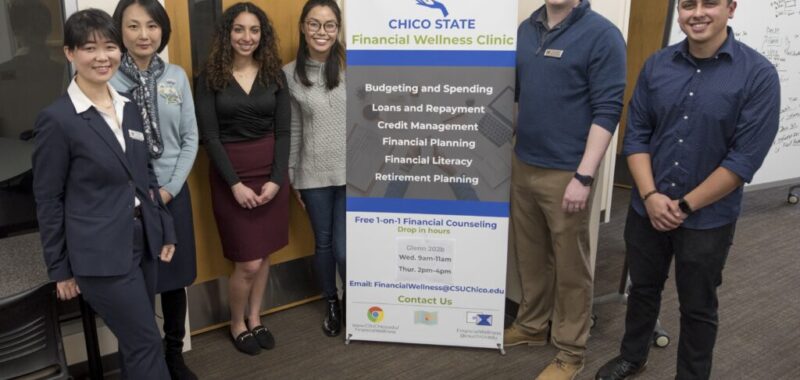Student para-planners at the Chico State Financial Wellness Clinic provide the campus community with free financial planning and education services overseen by a licensed financial planner.
Credit: Jessica Bartlett / Chico State
There’s a group of students whose fate has largely been forgotten amid the shifting political and policy landscape of higher education. It’s young people from lower-income backgrounds who are taking classes and studying while also working, caring for their families, and struggling to afford housing and basic needs, such as food.
As the shifts continue, institutions and their allies can step up and do more to ensure these students complete their studies and realize the lifelong benefits of graduating with a bachelor’s degree. And they can do so by prioritizing affordability, recognizing that cost is often a major barrier to student success.
Consider the example of Dejanae Wilson, who graduated from California State University, Chico, last year with a bachelor’s degree in social science. While working toward her degree, she was also caring for three younger siblings.
“I had a lot on my plate trying to manage our finances and keep up with my courses,” she said.
To ensure that Dejanae could graduate on schedule and according to plan, she turned to the recently established Financial Wellness Clinic at Chico State. Thanks to consultations with both a student and a faculty adviser at the clinic, she managed the household budget and connected to campus resources (like the Hungry Wildcat Food Pantry), which offered her family crucial support.
“It’s easy to get caught up in the flow of life, your job, and taking care of people — and not realize there are resources on campus that can help,” Dejanae said.
Across California State University’s 23 campuses, administrators, faculty and students are working diligently to support students like Dejanae to complete their studies on time and according to plan. From expanding mentorship, tutoring, and academic advising, to increasing access to financial counseling, to instituting early warning systems to identify and support struggling students, campuses are piloting a range of promising approaches to support student persistence and success. These approaches often build on existing campus policies and programs, making them impactful and achievable.
The Financial Wellness Clinic at Chico State, led by finance professor Jaycob Arbogast in the university’s College of Business and staffed by finance students, is just one example of these practical and effective strategies. This well-organized and structured program, which seamlessly integrates classroom learning with practical experience to support student needs, was recognized for its effectiveness and bestowed the prestigious Catalyst Fund award by the National Association of Higher Education Systems. The awards recognize replicable programs and strategies that California’s public colleges and universities are pursuing to remove cost as a barrier to higher education.
At CSU Channel Islands, another innovative initiative that received Catalyst Fund support has provided additional resources to students who are struggling academically so they can stay on track and reduce the time (and costs) of earning a degree. Launched in spring 2022, the initiative targets students who have nonpassing or incomplete grades and/or other indicators that they are not progressing academically. The program connects these students to faculty and peer mentors and special, cohort-based activities where they bond with other students and develop skills and mindsets that support their persistence and success.
Early results from the program show that participating students’ average GPAs increased, and the percentage of students who graduated or returned for the following semester was higher than that of the general student population. Interestingly, one of the key benefits students point to is how the program builds connections with peers facing similar challenges. As one student said after participating in the program, “You are able to be part of a group that becomes your family, you learn about the experiences of other students, and realize you are not alone.”
Supporting students to persist in their studies can take several forms. At Sonoma State University, students who are the first in their family to go to college are 47% of all undergraduates. As university officials started to see a decline in retention among these “first-gen” students during the Covid pandemic, they developed an early alert system that pings a student and connects them to their adviser and other support when a faculty member reports low test scores or attendance problems. At the end of the program’s pilot year in 2023-24, 97% of first-year, first-gen students enrolled in the program ended in good academic standing and returned the following fall.
What’s happening at Sonoma State and the other CSU campuses is part of a broader commitment to closing the equity gap in higher education across a university system that, despite its uniquely diverse student population, continues to experience racial disparities in degree completion. It was in response to these disparities that CSU set a goal to increase graduation rates between 2015 and 2025. Thanks to Graduation Initiative 2025, the system has nearly doubled its four-year graduation rate for first-year students, and undergraduates are earning their degrees faster than ever before.
Expanding access to a bachelor’s degree and supporting student persistence and success are core functions of the higher education system. In California and across the nation, campuses are showing it’s possible to do better, even in today’s uncertain political and policy environment. All it takes is creativity and a commitment to students who might otherwise struggle to achieve their college dreams.
•••
Dilcie Perez is a deputy vice chancellor and chief student affairs officer for the California State University system. Monica Martinez is program director for college success at the Evelyn and Walter Haas, Jr. Fund.
The opinions in this commentary are those of the authors. If you would like to submit a commentary, please review our guidelines and contact us.

